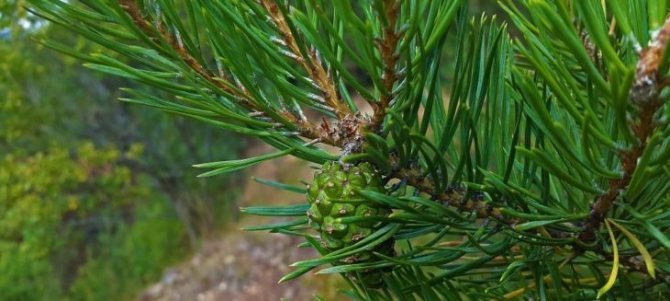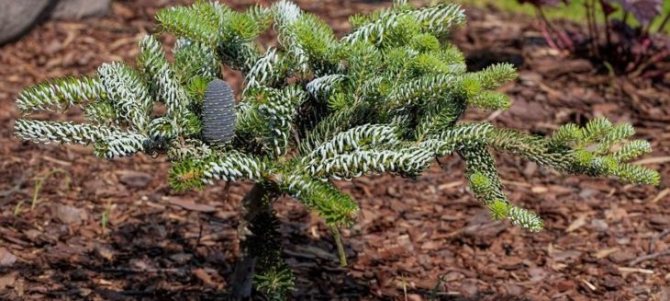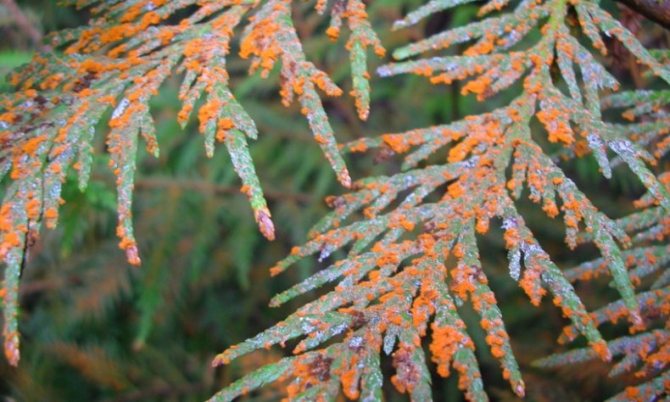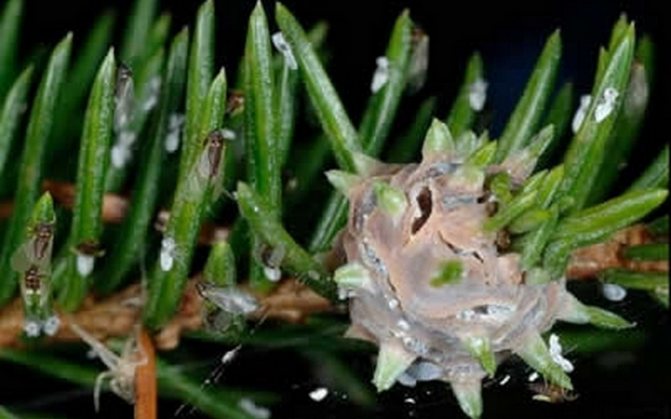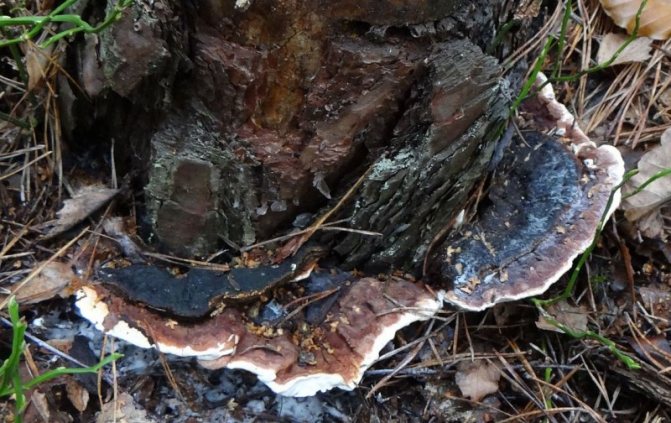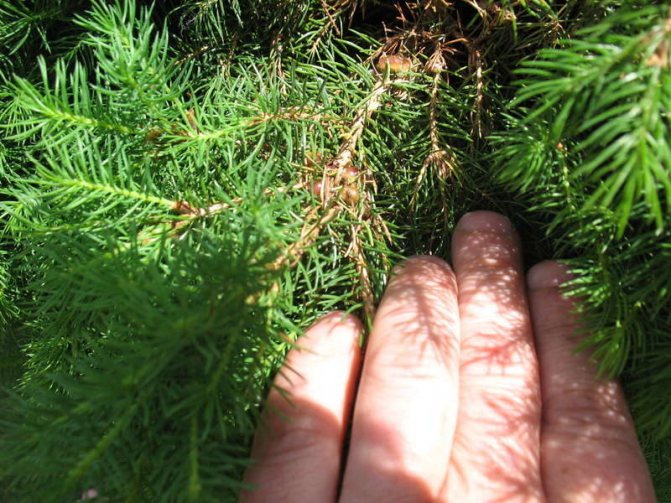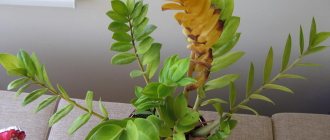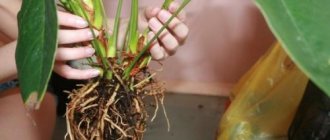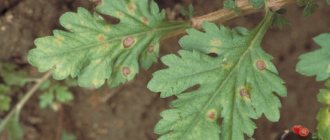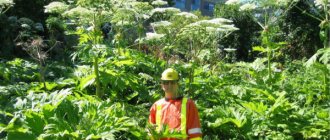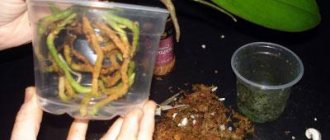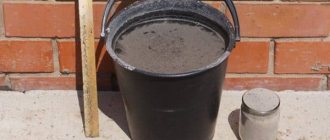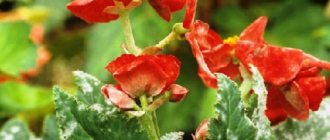Coniferous shrubs and trees are an original and special decoration in gardens. Recently, the use of green plants in design planning near water bodies, creating hedges, etc. has been in special demand. The advantage of conifers over deciduous trees is their durability and reliability. You can admire the beauty of flowers only for a short period during the summer, and enjoy the green color and fresh scent of coniferous resin - in winter, spring, autumn and summer. Conifers in compositions together with other garden trees look very beautiful, but autumn is the period when you will need to worry about them to some extent. Like all plants, conifers need fertilizers for rapid growth: such top dressing will keep your plantings decorative throughout their life. Of course, you can use universal fertilizers for conifers, but preference should be given to special ones. You will learn about the composition and methods of using the most effective of them on this page.
Fresh articles about garden and vegetable garden
Salting cabbage in February 2020 according to the lunar calendar
How to treat pepper seeds with hydrogen peroxide before planting seedlings?
Processing pepper seeds before planting seedlings with potassium permanganate
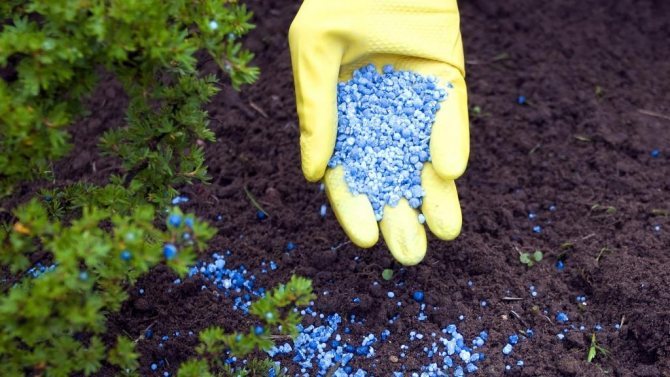
Features of the life of conifers
Ephedra are unpretentious plants, they do not require a sufficient amount of moisture, light, heat. Feeding has an exclusive function - the growth of the tree. But at the same time, gardeners need to remember about their characteristics and sensitivity to chemical and organic fertilizers. It is known that they do not tolerate a large amount of nitrogen substances in the soil, reacting to it with chlorosis or the death of individual parts. The needles are not very sensitive to photosynthesis, so they constantly need to lime the earth (it is better to use dolomite flour). It should also be remembered that the soil should contain as many trace elements as possible, such as potassium, phosphorus, magnesium, etc.
Time of work
Preparation for winter begins from the very beginning of autumn. Conifers are treated for diseases and pests, if necessary, mulch, spill, remove weeds. If we talk about feeding, then it is usually applied twice: in May (during the period of active growth and development) and in August-September.
If you are late with the autumn fertilization, then young conifers will simply have a nutritional deficiency. After all, they will spend a lot of effort on rooting. It is more difficult for hungry trees to survive in winter, they are more likely to die.
If you plan to use liquid formulations, then you should strictly follow the instructions. A highly concentrated solution will destroy the root system. To apply top dressing, a shallow circular groove is dug. Nutrient composition is poured there.
If granular fertilizer is used, do not leave it on the surface. It should be embedded in the soil. In parallel with fertilization, dolomite flour is often applied, which not only deoxidizes the soil, but also supplies it with a number of microelements.
Protecting conifers from the bright sun in early spring
All conifers that do not shelter for the winter can suffer from the bright spring sun. Needle burns occur not so much from the sun itself as from the sun's rays reflected from the snow.Experienced gardeners in the spring sprinkle the snow around their conifers with earth, harvested in the fall, or ash. This is a good way to protect conifers from burns, but with repeated snowfalls, it is quite time consuming.
Most species of conifers grow well and thrive even in the most difficult climatic zones. But the harsher the climate, the more care these evergreens will require from you. Particular attention should be paid to preparing for winter. But, as you can see, there is nothing complicated here either - the usual procedures, which should not be neglected. By performing all the preventive measures described above, you will get rid of possible problems with the wintering of your conifers and ensure their health for the entire next season.
When to fertilize ephedra
Unlike many deciduous plants, when planting conifers, it is not recommended to apply fertilizers to the soil, since they promote the growth of vegetative organs and the plant begins to actively build up green mass. And our task is to give the coniferous plant a good root first. This will help drugs such as rooting.
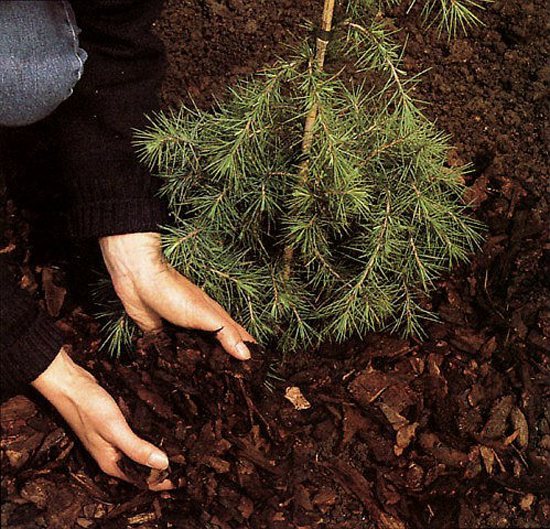

Special additives for ephedra
To facilitate the calculations of fertilizers for ephedra, special mixtures were created:
- Fertika-Lux;
- "Health turbo for conifers";
- "Aquarin";
- "Khvoinka";
- Green Needle;
- "Fertile universal for conifers."
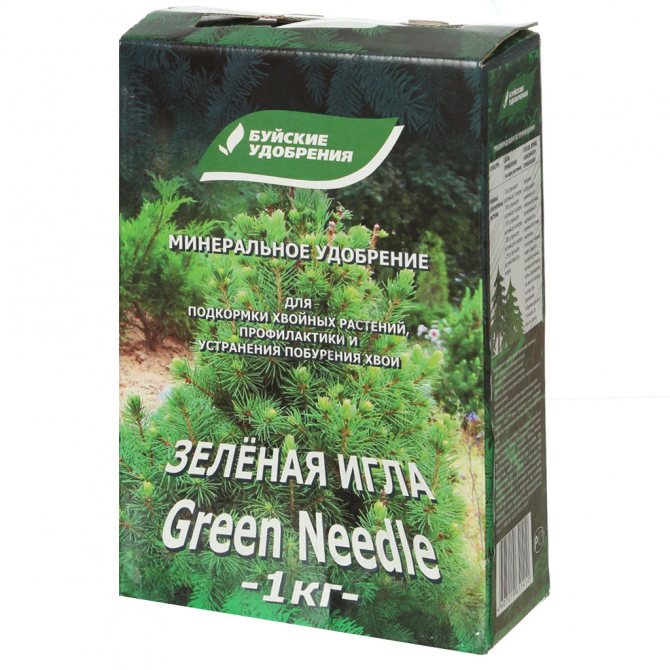

"Fertika-Lux" is recommended by some amateurs as a fertilizer for conifers, but it contains no magnesium and a lot of nitrogen (16%). This mixture can be used in diluted concentration. once every five years.
"Zdraven turbo for conifers" is a more acceptable option for spring fertilization. There are most of the essential trace elements, among which there is magnesium. But the nitrogen content is worried - 22%. It is not recommended to exceed the dosage of this mixture, and even more so to use it as an autumn fertilizer for conifers.
"Aquarin" is a water-soluble mixture that can be used for liquid feeding of conifers in the fall, but no later than the beginning of September.
Khvoinka is a good supplement for dwarf evergreens. The main application is in spring and summer, since the nitrogen content is quite high (13%).
Green Needle is an excellent fertilizer for conifers in autumn. A large percentage of magnesium and sulfur provide a bright green color to the needles all year round. Fertilizer for spruce and pine will help prevent yellowing of the needles. A small percentage of nitrogen (3.4%) makes it safe for all types of conifers.
What to remember
- Inspect young trees in early spring. After the snow cover disappears on the needles, the first damage and the development of diseases are noticeable.
- Trim. Remove affected parts on ephedra, burn together with mulch. Pests of conifers: fungal mycelium, insects.
- Process with 1-2% Bordeaux mixture. As a preventive measure in the summer, spray the trees with Bordeaux mixture several times.
- Do not set up coniferous beds near the forest. The proximity to forest plantations can kill many species of conifers in the garden.
{SOURCE}
Watering conifers in autumn
In the fall, conifers need sufficient watering. Many plants of this breed (for example, a spruce) have a large and dense crown, and therefore it passes moisture very poorly. It is not necessary to exclude such an option when, even after heavy rain, the ground under the spruce remained perfectly dry. If in the autumn period there was little or no rain at all, you all the more need to provide the plants with sufficient watering. This is due to the fact that in coniferous trees moisture evaporation occurs until frost, and therefore, if irrigated untimely, they can suffer from both drought and frost.
A separate issue is horizontal junipers
Separately, I would like to say about horizontal junipers. These are low-growing plants, the lower branches of which spread along the ground, due to which they are considered ground cover. The culture is represented by all kinds of miniature and dwarf plants with interesting color of needles - from bright green, like the junipers "Cossack" and "Prince of Wales", to blue, like the "Blue Chip" or "Blue Alps".
Young conifers that grow on the site for less than three years must be protected from frost.
Horizontal junipers do not need shelter, however, in spring, when the snow melts, the lower shoots are often in the water for a long time, and this can negatively affect the development of plants. In the fall, when preparing the garden for winter, you need to put large stones or bricks under the lower branches of the juniper, lifting the branches from the ground. It is undesirable to use boards or wooden blocks, since the wood gets wet, and various pests settle in the bark for the winter.
How to properly spray a garden in the fall: tips
- Observe the norms and dosage of the drug dilution, precautions for processing.
- Treat as late as weather permits.
- Use good sprayers that give a very fine spray - this reduces the consumption of the drug and delivers it to hard-to-reach places. It is advisable to use electric or gasoline sprayers to create a very fine mist under high pressure so that the solution gets into all the pores and cracks in the bark.
- Apply the mixture liberally, especially at the bottom of the trunk, to help the solution run down the tree and not just moisturize the bark
- In the fall, the concentration of the spray solution should be higher than in the spring (for example, in the spring during the growing season, preventive treatments with 1% solutions of copper or iron sulfate, Bordeaux liquid are allowed). During the autumn treatment, the plants have already gone into hibernation and more aggressive preparations can be used.
- Spray whole trunks and branches thoroughly, try to get to the tips of the shoots, in the forks of branches and other hard-to-reach places.
- Together with the plants, work the soil in the near-trunk circles, fallen leaves.
- Apply garden whitewashing as late as possible so that it does not wash away with rains and it does not turn pale, because its main function is to protect against sunburn.
- Alternate preparations and mixtures for spraying, do not use the same products for treatments.
| TIP Fallen leaves and plant residues after the autumn treatment with fungicides can be put into compost. |
If you do not compost and do not want to waste time spraying leaf litter, then it is better to remove fallen leaves from the site, thoroughly cleaning the near-stem zone. Plant residues can be buried deep enough so that spores of fungi and larvae do not have the opportunity to get to the surface.
How to prepare conifers for wintering: treatment from diseases and pests
One of the important measures in preparing conifers for winter is preventive treatment (spraying). Even if no diseases or pests were noticeable on the plants, it is still necessary to carry out preventive spraying.
To begin with, the plant needs to be cleaned - remove all dried or broken branches with pruning shears, remove spoiled needles from thujas. If the plant is large and thickened, it is necessary to move the branches apart, because it is near the trunk that spoiled needles can be found. All cut out parts from the site must be removed, or better - burned.
For the prevention and treatment of fungal diseases, coniferous plants must be sprayed with a 1% solution of copper sulfate or "Fitosporin". How to dilute Fitosporin correctly is described in detail in the instructions attached to the preparation, which cannot be said about copper sulfate.
To obtain a 1% solution of it, it is necessary to dilute 100 g of powder in 10 liters of water.To do this, pour the powder into a plastic bucket (you cannot use iron dishes) and mix with a little water. Then we add the volume to 10 liters, adding water heated to 45-50 o C. In warm water, the drug dissolves better. Strain the mixture before spraying. Processing is carried out in dry, calm weather, in the morning or in the evening. The air temperature must be at least +5 o C.
Mulching conifers in autumn
We have already mentioned soil mulching when planting seedlings. Will not interfere with mulch and adult conifers. It smooths out sharp changes in air temperature, does not allow moisture to evaporate, and inhibits the growth of weeds. The structure of the soil is improved under the mulch, because earthworms are actively bred in it. Mulch is laid in a layer of 4-5 cm, using sawdust, chips or bark for it. Planting ground cover species can be a good alternative to mulching.
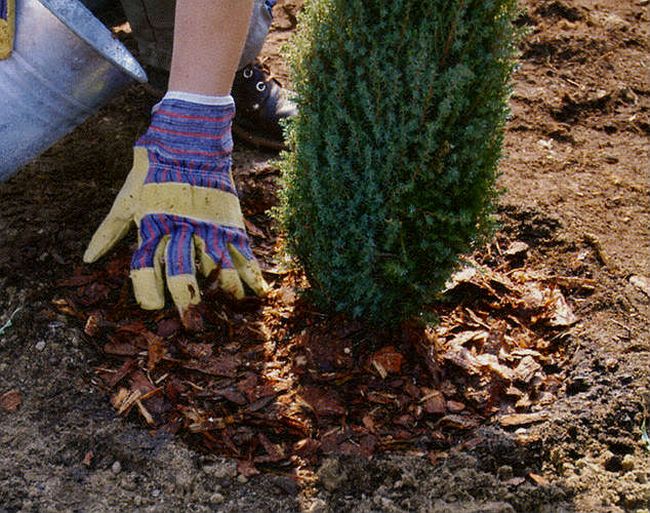

Water quantity rate
The amount of water required depends on many factors. The agricultural technology of a particular plant, the size and age of the tree also play a role. Young seedlings and bushes of currants, raspberries and blackberries need 4-5 buckets of water. A tree aged 5-7 years will need twice as much water, pour 8-10 buckets. Adult fruit trees need up to 200 liters per tree. To calculate the amount of water for a tree, mentally project its crown onto the ground. For 1 sq.m. use 90 liters of water. Another little tip: don't pour all the water you need under the tree in one go. Moisture-charging irrigation is carried out in 2-3 stages.
Fertilizers and feeding
Conifers need adequate nutrition, but not all fertilizers are equally useful for them.
Rules for choosing feeding
- Conifer fertilizer should contain a minimum of nitrogen.
- Magnesium in the top dressing should have an easily digestible form.
- A large number of trace elements will only benefit plants.
When choosing a nutrient, it is imperative to be guided by the above rules, because an incorrectly selected fertilizer will only cause harm. Gardeners advise it is better to skip feeding than to ruin the plant by wrong actions.
It is enough to feed the conifers twice a year: in spring and autumn. The second top dressing is designed to prepare the plants for the cold season, to assist in the maturation of growth over the past year.
It is especially important to apply fertilizers for young conifers, the root system of which is not yet sufficiently strong and is not able to independently extract food from the soil.
Organic
Conifers should not be overfed with organic matter for the winter. In young plants, excess nutrients can cause burns. In addition, autumn overfeeding will disrupt the process of preparing plants for a dormant period.
Compost
Over-ripened plant residues are a traditional type of fertilizer for conifers. It is this fertilizer that serves as an excellent imitation of the native forest soil. Plants are so responsive to composting.
They are fed as follows: the top layer of soil under the tree is thoroughly loosened, then sprinkled with a layer of compost (8-12 cm is enough). Fertilizer should not be left on the surface, because it is slightly embedded in the soil. This will make it easier for plants to absorb nutrients.
If there is no compost heap on the site, you can purchase ready-made compost-based fertilizers.
Some gardeners instead use a vermicompost solution or an ordinary herbal infusion (popularly called green fertilizer). The conifers will also like the fertilizer from the coffee cake.
How to feed the conifers in the fall
Ordinary garden mixtures and complex fertilizers, such as azofoska, are not suitable for evergreens. Even worse - manure and various tinctures of green grass and weeds. They cause rapid growth, which ends in yellowing, and even the death of individual specimens.And it's not about the amount of feeding, but about its composition. It is better not to feed the conifers at all than to do it wrong.
On sale you can find many special fertilizers designed specifically for conifers. But, before buying the products of even the most famous company, you should carefully check the chemical composition of mixtures, both domestic and imported. What criteria should be followed?
The total area of needles of coniferous plants is many times less than the area of leaves of deciduous trees of similar size. At the same time, they receive most of their nutrition not from the roots, but through photosynthesis. And this process is impossible without magnesium, which is an integral part of the chlorophyll molecule. Therefore, the presence of magnesium is a prerequisite when choosing a fertilizer for feeding conifers.
For the nutrition of evergreens, it is completely unacceptable to use fertilizers containing a high percentage of nitrogen. Moreover, at any time of the year. This element provides an intensive growth of green shoots. The growth is so fast that such branches do not have time to ripen. And, as a rule, they are damaged during the winter cold. It is for this reason that manure, in any form, even diluted mullein, cannot be used for ephedra.
According to experts, predominantly mineral fertilizers should be used for feeding conifers. The best organic matter for them is well-rotted compost, as well as vermicompost - a product of earthworm processing.
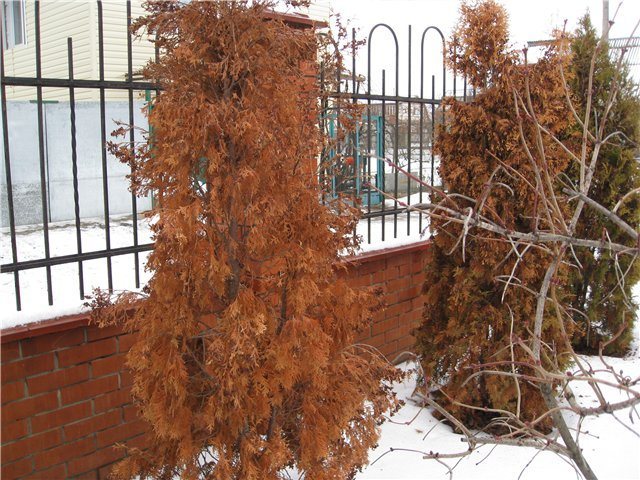

Winter drought
Studies carried out in the European part of Russia, Siberia, and the Urals have shown that trees that do not have enough moisture tolerate frosty winters poorly. In this article, we'll talk about the importance of pre-winter watering and how to properly administer it.
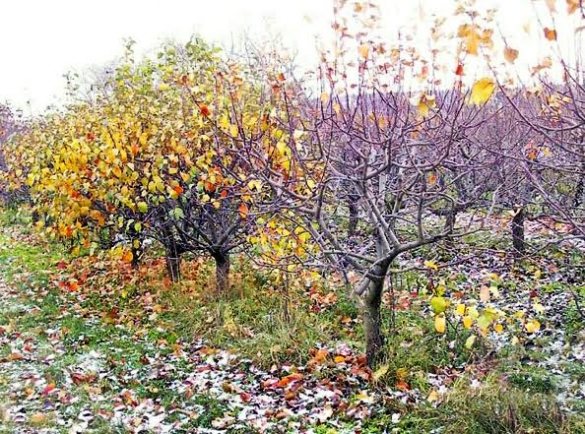

Most of our regions have harsh, long, uncomfortable winters, with frosts and winds. The gardens seem to be dries up with an ice hair dryer, and then cold, prolonged springs with recurrent frosts are still ahead. In winter, tree branches continue to dehydrate. According to various studies, conifers and shrubs lose 3-15% of moisture at this time of the year, and deciduous trees generally lose 20-65%.
Winter dehydration is aggravated by low soil moisture in autumn and winter. If the summer was hot, the autumn was dry, and the trees in the orchard were watered infrequently, and the moisture-charging pre-winter watering was not carried out, then the chances of a successful overwintering of plants are greatly reduced.
For many years, a large study of the effect of soil moisture on the overwintering of fruit has been carried out in the Moscow region. As it turned out, most of the trees died in frosty winters that came after dry summers and autumn, especially in the winter of 1940 - before that, there was a drought in the region for two summers. The same study shows that in other frosty winters, trees were not affected, but they were preceded by rainy summers and autumn.
Therefore, it is difficult to overestimate the importance of water charging irrigation. And it is better if it is combined with watering during the entire growing season.
FORUM HOUSE user DaOlya claims that pre-winter watering helps keep the tree root system from freezing. The root system of trees is better protected than the ground part, but in early winter, when there is still little snow and frosts have already begun, problems are possible.
- If the dry ground has time to freeze, for example, by 30 cm, then wet, keeping heat longer, by 10 cm.
This difference can be decisive for many young trees, shrubs and other plantings such as strawberries. In mature trees, the roots go deeper, so they will tolerate frosts more easily. It is interesting that, no matter how much snow piles later, this will not change the depth of soil freezing.
To make sure that pre-winter watering will be necessary for your garden, such a simple method will help: you need to look at the state of the earth at a depth of one and a half bayonets of a shovel. If the soil is dry, does not gather in a lump in your hand, or disintegrates, then you cannot do without water-charging irrigation. How much water should you need? Agronomists say: "until the root layer is completely saturated." In general, this procedure, like everyone else, requires an individual approach to each garden, taking into account the level of groundwater, and drainage, and the quality of the soil. But the soil is soaked deeper than with conventional watering, not just to the entire depth of thin roots, but approximately 15 centimeters deeper. Typically 10-15 buckets of water are taken per square meter of soil for a mature tree.
And even if autumn is generous with rains, it is believed that the soil is still not saturated with water enough. Ideally, she should get wet to a depth of one and a half, or even two meters. Then this will be enough for a successful wintering not only for shrubs, but also for trees.
In various sources, you can find rates for pre-winter irrigation, these are very large volumes. As you find it, the hunt will be lost to do this.
Why, when doing water-charging irrigation, gardeners try to wet the soil as deeply as possible? The fact is that frost at the beginning of winter "draws" moisture from a depth of about 20 centimeters: in wet ground, the partial pressure is directed from the ground - upwards, that is, towards the cold. Therefore, the layer in which the roots are placed must be soaked as deeply and best as possible.
Opinions on the timing of pre-winter irrigation differ. Some respected experts believe that the best time will be the end of September - early October, others - that the end of October - early November. Everyone has their own arguments, and often watering is carried out at different times, even in the same region.
It has been noticed, in practice, that the frozen wet earth does not allow frost to penetrate into the depths, acts as a barrier. But this event is useful to do when the weather changes to a steady minus. This is most likely after mid-November.
But, in any case, it is impossible to carry out water-charging irrigation before the fall of leaves, especially when it comes to a young garden. Shoots can grow, and this will negatively affect the readiness of the plant for overwintering. The temperature can also serve as a reference point: it should steadily drop to + 2- +3 degrees.
How to water? Most gardeners are not smart and leave a hose under the tree for a long time. But this method is good for a flat area. Sprinkler irrigation is suitable for a garden located on a slope, but water overmoistening is inevitable, which, in turn, creates a favorable environment for the development of diseases. So, you may still have to carry water in buckets.
After pre-winter watering, the trunks are mulched with peat, straw or fallen leaves.
Activities that help plants not die from winter drought:
- For planting in the garden, choose zoned, winter-hardy varieties.
- Non-susceptible varieties must be grown in shale form (or bend down to the ground in the fall). Make sure these plants are completely covered with snow.
- The plant will accumulate moisture, and in winter it will compensate for its loss if its root system and aboveground part are protected from damage.
- The trees of the first year of life should also bend to the ground and be covered with snow.
- The branches of young trees are tied with moss, paper, etc.
Preparing for winter
It is necessary to prepare conifers for the cold season in advance. In the fall, they are spilled well (up to 9 buckets for each plant), young trees are mulched with bark, fertilizers are applied. Some gardeners prefer to feed the ephedra in the fall with rotted compost (they cover the plants with a layer of 5 cm or more), others use special purchased fertilizers.
Trimmed conifers cover for the winter. This is done after abundant watering and feeding.In the cold season, it will not be possible for plants to receive adequate nutrition, and therefore they must make the necessary supply from the fall. The main thing is to observe the dosage and not "overfeed" the conifers.
Note. If you apply too much fertilizer in the fall, the plant will grow vigorously and will not be able to prepare for winter. The result can be deplorable - the ephedra will freeze.
These trees are in great need of magnesium. It is this element that is responsible for the integrity of the needles. With a deficiency of magnesium, the needles turn brown, dry out and crumble. This is most pronounced during the dry season. To compensate for the lack of this trace element, it is better to use liquid mineral complexes specially designed for conifers.
Determining the need for watering
In the fall, the soil should be soaked very deeply - by 1-1.5 m. How do you know how much to water the soil for you and in this particular season? To do this is both simple and difficult at the same time. You need to dig a hole 30-40 cm deep in the garden among the trees that are going to be watered. The condition of the soil at the bottom of the hole will help you establish the degree of soil moisture in the current year:
- no need to water the garden before winter, if you take a handful of earth from the bottom of the pit and squeeze it in your fist, you will get a dense lump; on a blotter or just a piece of cheap toilet paper, a wet trail will remain from such soil - evidence of its sufficient moisture;
- you can reduce watering rates by 30%if a lump of earth compressed in the palm of your hand forms and does not disintegrate, but does not leave a wet mark on the paper;
- water at full rate will have to, if the compressed handful of earth from the bottom of the pit crumbles when you open your palm, does not hold on to a lump.
Time for autumn watering
And watering at the full rate will have to be quite serious. About 10-14 buckets of water per 1 m² area for mature trees and at least 3 buckets for a young meter tall tree.
Foliar feeding of conifers in autumn
Foliar dressing is widely used in modern methods of plant care. That is, the introduction of drugs by spraying them in an aqueous solution over the needles. When fertilizing at the root, only 20% of the nutrients are used by the plants. At the same time, the processing of plants with needles using the foliar method is much more effective and allows you to assimilate up to 80% of nutrients from the preparations. For dense planting of plants, for example in hedges, foliar feeding is especially recommended. In addition, the doses of drugs used for foliar application are lower than for root application. The drugs enter the plants directly and within five hours the nutrients already begin to participate in the metabolic process.
Sowing calendars for 2020
Lunar calendar for December 2020 of the gardener and gardener florist
Lunar sowing calendar for September 2020 of the gardener and gardener
Lunar sowing calendar for october 2020 of the gardener and gardener
Lunar sowing calendar for November 2020 of the gardener and gardener
Shelter of conifers from snow and frost
Thujas, yews, junipers and cypresses in winter can be threatened by snowfalls. The abundant snow, even if it does not break the branches, will break them apart in different directions, and the tree will lose its shape. To prevent this from happening, it is necessary to wrap the plant in a spiral with synthetic twine, lightly pressing the branches against the trunk.
Young conifers that grow on the site for less than three years must be protected from frost. The best material for insulation is burlap, as it allows air to pass through well and reliably protects from frost. Many gardeners use ordinary gauze, wrapping the plant in two layers and securing it with twine. You can use agrofibre, but on condition that it will be possible to remove it in early spring, otherwise there is a threat of damping.
In special gardening shops, a net for sheltering conifers began to appear.This is ideal - hide and forget. For those who care about the aesthetics of their garden, you can find on sale special caps for conifers of different sizes and shapes. They are very comfortable, just put on the plant and tighten with a cord at the bottom. The caps are made of special breathable fabric and have a very nice look.
Conifers living on the site for more than three years, as a rule, have already adapted to the environment and do not need shelter.
Young conifers planted this year do not have time to take root firmly in the ground by winter. They need to be strengthened with stretch marks. To do this, 3-4 strong ropes are tied to the trunk. Pegs are driven into the ground along the perimeter of the seedling, to which the free ends of the ropes are attached. Such a measure will not be superfluous - the fixed seedlings will withstand strong blizzards and will not bend under the snow.
Autumn garden prevention and plant protection in autumn
To see your garden healthy in the spring, include preventive treatments and plant protection in your garden work in the fall.
- Preventive treatment and protection of fruit trees and shrubs
- Preventive treatments and protection of conifers
- Preventive treatments and protection of grapes
- Preventive treatments for roses
- Greenhouse preventive treatment
- Greenhouse preventive treatment
- Preventive lawn treatments
- Preventive treatment of plants in a flower garden
- Whether to whitewash the trees
Preventive treatment of fruit trees and shrubs
After leaf fall, copper-containing preparations are used: 3% Bordeaux liquid or copper oxychloride, as well as systemic fungicides ("Skor", "Horus"). Treatment of fungi and pests with tank mixtures can be carried out simultaneously. Be sure to process not only the trunk and branches, but also the trunk circles. Before spraying with fungicides, be sure to clean up all problem areas on the trunks and branches of fruit trees: places of lagging bark, cracks. Lichens are abundantly irrigated with a 3-5% solution of ferrous sulfate, which causes them to gradually dry out.
If you were forced to remove diseased parts of the plant or an accidental breakage of branches occurred, disinfect the wounds with a 3% solution of copper sulfate and cover with garden varnish or paint. To prevent scab in apple trees, some gardeners spray trees at the beginning of leaf fall with a solution of urea (500 g per 10 liters of water). All spraying should be carried out only at a positive temperature, since water trapped in the crevices of the bark expands and tears tissue when it freezes.
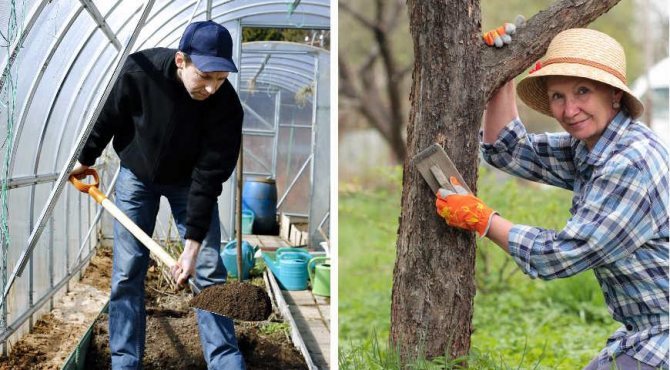

Preventive treatments for conifers
The most common diseases of ornamental conifers in the middle lane are common pine shute and drying of branches in juniper caused by fungal infections. For prevention, you can carry out autumn spraying with 1% Bordeaux mixture or substitute preparations ("Abiga-Peak", "Hom").


Preventive treatments for grapes
Adult vines before the shelter are treated with a 3-5% solution of ferrous sulfate, on young vines, a half concentration (1.5-2.5%) is applied. If during the season the grapes suffered from powdery mildew, it will be useful to thoroughly spray the plantings with colloidal sulfur or a special preparation based on it (for example, "Tiovit Jet"). Also, the preparations Topaz and Skor are used for powdery mildew; in cold weather, treatment with Horus is recommended, since other preparations lose their effectiveness at low temperatures.


Preventive treatments for roses
Before the shelter (late October - early November), to prevent infectious burns and fungal diseases, the plants are abundantly sprayed with 3% Bordeaux liquid. It is also advisable to treat bush species roses that do not need shelter with fungicides. When pruning old and thickening branches in the autumn, it is advisable to process large cuts with Ranet paste or garden pitch.
Greenhouse preventive treatment
For disinfection, the greenhouse is fumigated with a sulfur stick, you can additionally process structures, containers and tools with copper sulfate using a brush or sprayer. For soil disinfection, special preparations are suitable: "Fitolavin" against bacteria and "Pharmayod" - against viruses. But if the soil is infected with nematodes, it will have to be completely replaced, and it is categorically impossible to reuse this soil in the garden and the garden: the nematodes will spread throughout the site. Three weeks after sanitizing the greenhouse, add biologically active substances to the soil. The optimal choice is complex preparations with live cultures of microorganisms and bioactive components: "Baikal EM 1", "Biocomplex-BTU". These preparations contain nitrogen-fixing, phosphoric, potassium-mobilizing, lactic and fungicidal bacteria, vitamins and a number of other useful substances. This composition helps to balance plant nutrition and protect seedlings from diseases after planting in the ground.
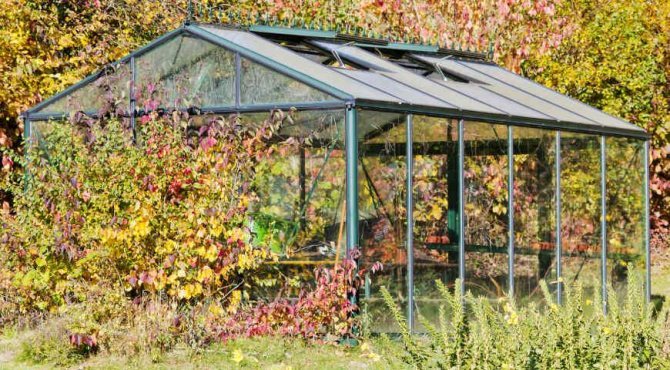

Preventive lawn treatments
To prevent fusarium snow mold, rot and other fungal diseases, the lawn is treated according to the instructions with a special preparation (for example, "Healthy Lawn"). Some studies indicate an increased risk of spring lawn grass diseases due to the use of nitrogen in August and potassium in late autumn, damaging the lawn and trampling snow cover in winter. Preventive treatments in regions with high snow cover should preferably begin at the end of August.
Preventive treatment of plants in a flower garden
After cutting the flower garden and harvesting plant residues, it is advisable to spray with a 1% Bordeaux mixture or a solution of ferrous sulfate in the same concentration.
When, how and what to whiten trees
It is believed that whitewashing, to which copper sulfate is sometimes added, protects the bark from cracking under the influence of the bright sun in February - early March and serves as a prevention of fungal infections. Meanwhile, many modern experts on fruit crops are of the opinion that whitewashing is not so useful. The fact is that a significant number of commercially available compositions are based on synthetic film formers (for example, acrylic or latex). This whitewash is very stable, practically does not wash off by rains and does not need frequent updating, which attracts gardeners. However, it is precisely because of the synthetic base that it does not allow air to pass through well, the bark under it does not breathe, it grows rotten and can die off in 3-4 years. This is especially detrimental to young trees, which have not yet formed a thick cork layer.
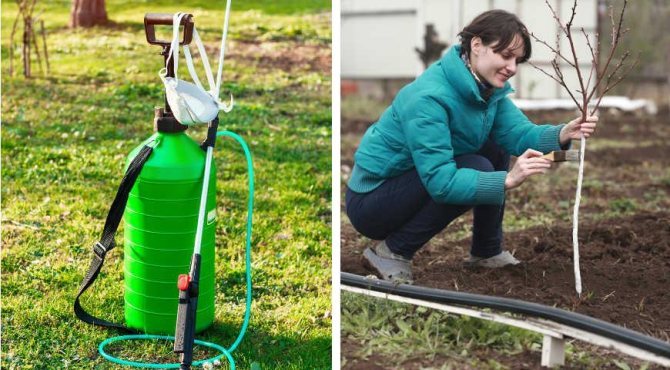

If you have a traditional whitewash approach, it is best to use a classic lime or clay based formula, and only for young trees with smooth bark. You can prepare your own garden whitewash. To do this, 2.5 kg of fresh lime and 1.5 kg of clay are diluted in 10 liters of water and 0.5 kg of copper sulfate is added. For better adhesion to the bark, you can also add 0.1 kg of wood glue. The stability of such compositions is low, they are easily washed off, therefore, when applied in autumn, it may be necessary to update the whitewash in January, especially if the winter was damp. Trees can only be whitened in dry weather; the bark must also be dry. Whitewashing must be applied not only to the bole, but also to the bases of all skeletal branches to a level of 1.5–1.7 m above the soil surface. The branches of the crown do not need to be whitened.
Fertilizer for conifers
Coniferous shrubs, like most deciduous ornamental shrubs, can do without additional feeding for several years if the soil composition suits them.This is understandable: coniferous shrubs are mostly evergreen, foliage does not shed, and therefore do not lose the supply of nutrients made the day before, like, say, abundantly flowering and fruiting deciduous relatives.
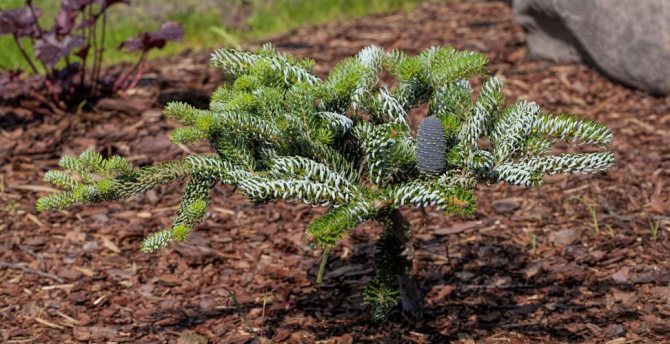

But sometimes it happens that the soil is poor in organic matter or there are not enough nutrients. The acquisition and maintenance of conifers is an expensive undertaking. Therefore, when buying a new plot where the composition of the soil is not known, it is advisable to carry out soil analysis in a soil science or agrochemical laboratory. This will help determine its composition, identify deficiencies and recommend methods for their elimination.
It would seem, why do we need feeding conifers in the fall? In winter, plants sleep and do not consume nutrients. And the thing is that autumn feeding is needed for the roots to work, which continue to function even in winter until the soil is completely frozen.
It is preferable to feed with a solution of fertilizers - this way fertilizers for conifers will quickly penetrate into the deep layers of the soil, where they will be especially needed in case of a rapid onset of frost. The area of the trunk circle is watered with a solution of fertilizers within a radius of a meter - one and a half, avoiding contact with the needles and the root collar. The maximum late and optimal application time depends on the growing region. So, in the middle lane, it will be possible to feed conifers in mid-late October, about a couple of weeks before the onset of cold weather.
In urban landscaping, you can often see tree trunks dug to improve nutrient permeability to the soil. This is not relevant for conifers and shrubs. A large number of their roots are superficial and can be damaged by equipment. After applying the fertilizer for the last time in the season, it will be more effective to mulch the soil surface with the bark of coniferous plants, if this has not been done earlier. This will reduce the evaporation of moisture, which does not lose its relevance in winter, and additionally insulates the plant.
Junk food for conifers in the fall
As already mentioned, the main enemy for evergreens is nitrogen. In this regard, it is necessary to exclude all fertilizers containing this element for conifers. The main such fertilizer is manure, whose composition is overflowing with nitrogen content. Adding it to the soil will ensure the "burning" of the entire root system, both young and mature conifers. Also, manure can lead to the formation of shoots, the growth and development of which does not always end by the winter period, as a result of which immature growths simply die due to cold weather. Manure can only be applied in the form of humus (three-year period), and it is not applied, but sprinkled on the ground around the plant. This procedure is carried out in the spring.
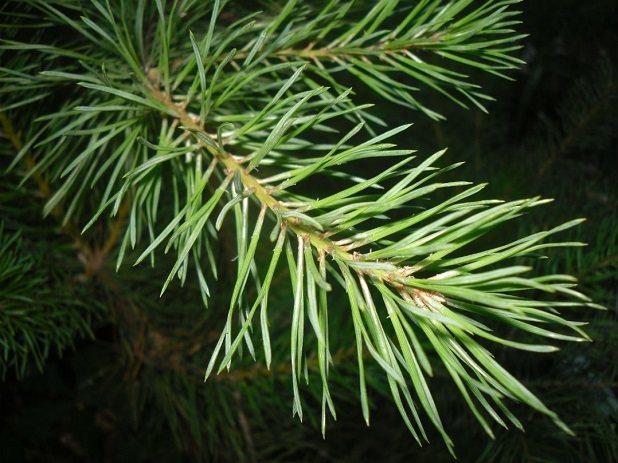

Why is nitrogen dangerous for conifers?
A high concentration of nitrogen in the soil contributes to the formation of new shoots, which do not always have time to grow by winter, which is why they die in the cold period. And shoots that survived the winter get very sick in the spring-summer period, which also has a detrimental effect on the growth of conifers.
The very formation of shoots in such conditions and the subsequent struggle for their survival take away too much strength from conifers. Therefore, mineral fertilizers, biohumus and compost are most suitable for feeding these plants.
When planting and mulching, peat, leaf humus, and complex compost are used. Thanks to them, plants receive nitrogen, phosphorus and potassium in the optimal amount and form.
Popular drugs
Well-known, widespread products that can be purchased in stores.
Florovit
A fertilizer specially developed for conifers, containing a minimum amount of nitrogen, a lot of phosphorus, potassium and magnesium. Autumn feeding with this preparation not only nourishes the plants, but also increases their immunity, allowing them to survive even a fierce winter. Release form - bags, plastic buckets of different weights.The approximate cost is from 620 rubles per 3 kg.
Osmocote
The fertilizer is remarkable for its prolonged action. As soon as the soil temperature drops below +5, the granules stop dissolving. They will continue to operate in the spring. And therefore, when it is introduced in the fall, there is no need for spring feeding. The approximate cost is 500 rubles per 0.5 kg.
Bona forte
Fertilizer is renowned for its economy. One package (5 kg) is enough to feed 200 conifers. In addition to the main macronutrients, it contains silicon and other trace elements. The drug prevents the browning of needles, strengthens the root system of plants. Chlorine free. Average cost - from 419 rubles for 5000 g.
The main diseases of ate and methods of their treatment
Consider what diseases of conifers exist and what determines their treatment. Fir tree diseases are most often caused by fungi and soil pathogens. Among all the diseases that spruce has, the tree is most susceptible to shute, fusarium, ulcerative cancer. Meanwhile, the diseases of conifers are not so terrible, therefore we recognize them and treat them according to the following tips.


The lesion is caused by several species of the Lophodermium pinastri fungus. The disease occurs in the month of May. If you notice the browning of the spruce needles, this is shute.
With the further development of the disease, the lower part of the needles is covered with shiny black growths of a dotted or dashed nature, which increase in size over time. Subsequently, the plant dries up and dies off. A particularly dangerous disease is for young plants (up to 10 years old) and seedlings.
The reasons for the spread of fungal diseases in spruce are warm weather and heavy rainfall (dew, drizzling rain).
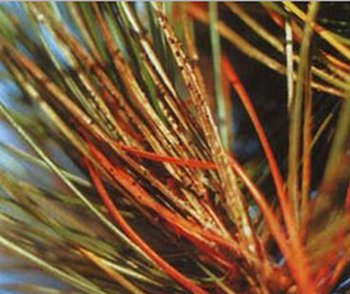

The source of this shute is the mushroom Lophodermium seditiosum. As a result of this disease, spruce needles fall prematurely. Seedlings in nurseries and young weakened plants are affected. During the spring and summer, the needles turn brown and crumble.
In autumn, small yellow dots appear on the needles, gradually they increase in size and acquire a brown color. The mushroom is preserved in the crumbling blackened needles.
Did you know?
Due to the even distribution of fibers in the wood, spruce is considered the best tree for making musical instruments.
The causative agent of brown shute, or snow mold, is the fungus Herpotrichia nigra. The disease occurs in several stages: infection with fungal spores begins in the fall, the development of the disease occurs in winter under a cover of snow at temperatures above 0.5 ° C. The disease manifests itself in the spring with snow melting.
A symptom of the disease is the appearance on the brown necrotic needles of a black-gray bloom, similar to a cobweb, and over time, the point fruiting bodies of the fungus.
Thin branches of trees die, the needles do not crumble for a long time. Young trees, seedlings and self-seedlings are exposed to the disease. Increased air humidity, dense planting of plants, depressions in the growing area are the main factors contributing to the ontogenesis of fungi.
The detonator of the snow shute is the Phlacidiumin festans mushroom, which has taken root well in heavily snow-covered regions. The development of the disease begins under snow at temperatures around 0 ºC. Infection occurs gradually: from needle to needle, and then from tree to tree. When the snow melts, the affected needles and branches turn brown and die off. Diseased trees are covered with gray mycelium films.
In summer, the needles change color from red-red to light gray, begin to crumble, but do not crumble. In the fall, black dots appear on the needles. Fungal spores from these points are carried by air currents to still unaffected spruce trees before the snow falls. Drizzling rain, warm snowy winter, long spring, falling and melting of snow in autumn have a beneficial effect on the spread of mushrooms.
Important!
Mushroom spores persist for a long time in dead plants and soil, therefore, when transplanting plants from nurseries, carefully treat the seedlings.
Control measures for shute consist in the selection of healthy seedlings that are resistant to the disease, early thinning and spraying of conifers with appropriate fungicides, copper-containing and sulfur preparations.
Tracheomycotic wilting refers to a viral disease caused by a soil pathogen. The root system of the plant is affected: the roots turn brown and begin to rot. The mycelium of the fungus damages the sap flow system, as a result of which nutrients do not reach the ground part of the plant.
Due to inadequate nutrition, the needles become red, then brown, crumble, and the tree dries up and dies off.
Coniferous seedlings are susceptible to disease in humid cold atmospheric conditions. The symptom of the disease is a gray-white bloom on the needles. The causative agents of the disease persist in dead plants and spread with seedlings or affected soil.
Treatment of fusarium spruce is impossible, after a few years the plants die. To prevent tracheomycotic wilting, it is necessary to plant healthy seedlings, carefully remove the infected parts of the plants. When the primary signs of infection are manifested, they are treated with biological products or fungicides.
Did you know?
In the fall, the trees shed their needles.
Rust diseases of spruces occupy a special place among all diseases to which conifers are susceptible, and their treatment should be aimed at eradicating the mushrooms Pucciniastrum areolatum, Coleosporium, Cronartium ribicola, which also affect deciduous plants. Ate is most susceptible to diseases such as cone rust and pine needles rust.
The fungus Pucciniastrum areolatum causes bud rust. A symptom of the disease is the appearance on the inner walls of the cones of round dusty brown eciopustules. Subsequently, the cones open wide and hang without falling off, the seeds lose their germination, the branches are deformed.
Needle rust is caused by the Coleosporium mushroom. A fungal disease develops in the spring, affecting the needles. Bubble yellow eciopustules are placed on both sides of the needles. If the plant is severely affected, the needles change their color from green to yellow and crumble.
If rust appears on the spruce, it must be fought with, as with other fungal diseases. It is also recommended to cut diseased branches and apply micronutrient fertilizers.
Bark necrosis
Bark necrosis is a fungal disease of the bark of branches. Signs of illness: darkening and drying of the bark, the formation of brick-colored growths or dark small bubbles. As a result, the bark dies and the tree disappears.
The fungus Botrytis cinerea is the carrier of gray mold. The disease affects the ground parts of young plants. The branches turn gray, brown or black. Covered with conidia, like a layer of dust. Infection of the plant continues during the growth process.
As a result, trees weaken and lose their appearance. Most often, the disease is common in areas with dense plantings, poor sun and air permeability.
Protective measures to prevent gray rot are the early removal of affected branches, disinfection of the cut sites with a solution of copper sulfate. If you think about how to treat conifers from diseases as a prophylaxis, Bordeaux mixture, "Skor", is a good remedy.
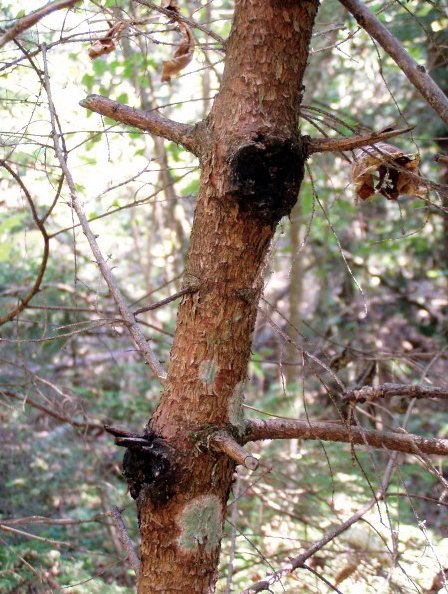

Spruce ulcerative cancer is caused by the mushroom Lachnellula pini. A sign of infection is the appearance of tar on the branches. Over time, depressed dead areas appear in the resinous areas, then cracks cover the bark, and closed or open sores form. Thin twigs die off without ulceration.
Open sores can be dry or moist. Dry ones look like small brown cocked hats. Wet ones are like saucers on a short stem, which are visible above the bark. The ulcers are covered with brown hairs with an orange round hymenial layer.Plants affected by cancer weaken and dry out.
The main measure in the fight against cancer is watering under the root with fungicides, treatment with copper-containing preparations, timely harvesting of dry branches, processing of cuts with garden pitch. Burning infected branches and needles.
Important!
Sick plants and their parts must be removed from the sites.
List of the best fertilizers
It is recommended to buy complex fertilizers, which contain iron and magnesium, as well as other macro- and microelements. They take part in photosynthesis, but when using mineral fertilizers, the dosage must be strictly observed.


For conifers, it is better to use complex fertilizers.
For uniform tree growth and brightly colored needles, organic matter is added. Biohumus is useful, the introduction of compost and mulching of the trunk circle has a beneficial effect.
Mulch helps to avoid the loss of nutrients, protects the soil from drying out. Biodegradable components such as sawdust or straw can be used.
Signs of deficiency of micro- and macronutrients
If the appearance of conifers has changed, this indicates a lack of nutrients. This condition is dangerous in that it leads to a decrease in the protective forces of the tree.
It can no longer withstand diseases, and its resistance to unfavorable environmental conditions decreases:
- Young spruces growing on calcareous soils are often affected by chlorosis. The needles become pale yellow, the trunk and roots develop poorly. To combat the disease, plants are sprayed with iron sulfate.
- Browning and yellowing often indicates that the soil contains a lot of sodium carbonate.
- Lack of phosphorus leads to a slowdown in the growth of spruce.
- The needles turn yellow prematurely if there is little potassium in the soil.
- With a calcium deficiency, the root system of the plant develops poorly.
- If there is little iron, then the needles become white, but they do not die off.
- With a lack of boron, seeds are not set.
Sources of infection in pines
Pines can get sick due to poor-quality environmental conditions, the presence of a source of infection, and the presence of pests. The development of diseases is facilitated by the accumulation of viral and fungal infections in litter (the so-called contagious beginning).
Nectric necrosis of the cortex
This fungal disease forms on the bark of the shoot, it is considered a cancer of pine trees. The disease causes browning of needles and stems. Young shoots dry up quickly. And on the bark, orange convex spots become noticeable, darkening over time. The infection persists even in the bark of a dead tree. Therefore, in order to prevent the spread of infection, such pines must be cut down, removed and burned.
Pine wither
It is a pine disease caused by the rust fungus Melampsora pinttorgua. The disease is characterized by the curvature of young pine shoots. Pine twirl is found both on seedlings and young pines up to 10 years old.
The disease is very dangerous for annual seedlings, and can cause their mass death. Shoot infection is typical for the second half of May.
Infection occurs with basidiospores formed on last year's fallen leaves (litter).
For prophylaxis in the spring, during the formation of basidiospores, it is recommended to spray with a 1% solution of Bordeaux liquid (3 times), a 1% solution of polycarbacin or a 0.8% solution of cineboma.


